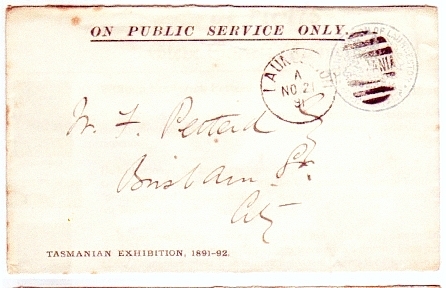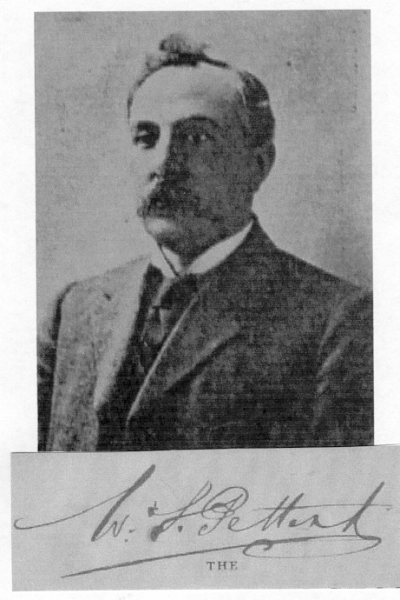This ON PUBLIC SERVICE ONLY stampless cover was addressed to W.F.Petterd, Brisbane St., City and it had a duplex cancel of LAUNCESTON/ A/ NO 21/ 91, TASMANIA which partially obscured a blue CORPORATION OF LAUNCESTON/ FRANK STAMP. There was a printed TASMANIAN EXHIBITION, 1891-92 in the lower left corner (Figure 1).

The reverse had a blue printed Tasmanian Exhibition 1891-2, Launceston with the Lion, Unicorn and crest in its centre (Figure 2).
William Frederick Petterd lived &/or had a business on Brisbane Street, Launceston in 1891, for the street was a very commercial one, even in those days. The only clue as to his commercial side was a citation that stated that Petterd was a scientist as well as a boot importer. His career was as a Tasmanian scientist noted for his contributions to the natural history of Tasmania, as a conchologist, entomologist and particularly as a mineralogist. He is regarded as the “father of mineralogy” in Tasmania (Figure 3).

Petterd showed a keen interest and curiosity as a gifted self-taught amateur of the natural sciences and one of his earliest works was a Monograph of the Land Shells of Tasmania, 1879. He had amongst his friends notable Tasmanians in the field of geology: W.H. Twelvetrees (Government geologist), W.F. Ward (Government chemist), W.R. Bell (prospector & mining speculator), and James (‘Philosopher’) Smith, the discoverer of the Mount Bischoff tin mine. Petterd named new species of minerals, some of which are still valid to-day, such as dundasite, heazlewoodite and stitchtite. His efforts were often a driving force in the development of Tasmanian silver-lead mining fields, and he was the chairman of directors of the Magnet Silver Mining Company, from its inception in 1895 up to his death in 1910.
Petterd’s first catalogue of the Minerals Known to Occur in Tasmania, with Notes on their Distribution,, was published in the ‘Papers and Proceedings of the Royal Society of Tasmania’ in 1893. In his introduction to the catalogue he states: “Of the minerals that have been discovered here (Tasmania) about 40 kinds have not been recorded as occurring in Australia. It will be found that the catalogue not only includes a large majority of the world’s economic minerals, such as the representatives of the Gold, Silver, Iron, Nickel, Cobalt, Wolfram, Bismuth, Titanium, Lead, Copper, and Platinoid groups, but also many species of considerable scientific interest, one or two of which are apparently new chemical compounds”.
Petterd bequeathed his collection of some 2,500 mineral specimens to the Royal Society of Tasmania, who loaned it to the Trustees of the Tasmanian Museum and Botanical Gardens, Hobart for a period of 999 years. The Petterd Collection provides the foundation of the present-day knowledge of Tasmanian minerals. Petterd was involved in the Tasmanian Exhibition 1891-92, perhaps as a commissioner. He was also known as a stamp collector for many years (as noted in his obituary).
The present paper could not have been written without web access to sites written by Steve Sorrell and Figure 3 is from his papers. Sue McClarron (Librarian, Launceston) provided an obituary published in the Daily Telegraph (16 April 1910), the day after he died at the age of 61 . Details from the obituary have been included in the main body of the paper.